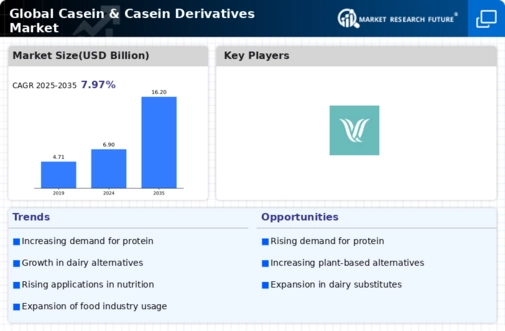Casein Derivatives Size
Casein Derivatives Market Growth Projections and Opportunities
The Casein and Casein Derivatives Market are shaped by a variety of factors that collectively influence its dynamics. One primary driver is the increasing demand for protein-rich ingredients in the food and beverage industry. Casein, a protein found in milk, serves as a valuable source of high-quality protein and finds applications in a range of products, including dairy, bakery, and confectionery items. The growing emphasis on protein-enriched diets and the recognition of casein's nutritional benefits contribute to the expansion of the casein and casein derivatives market. The global Casein & Casein Derivatives Market anticipates a remarkable growth trajectory, projecting a robust growth rate of 9.1% from 2023 to 2032. This surge is poised to propel the market to a substantial valuation of USD 12.9 Billion by 2032. Casein and its derivatives, integral milk proteins derived from various sources such as cows, humans, sheep, buffalo, and more, are key contributors to this upward trend. As versatile components, they find applications in a myriad of industries.
The sustained growth of the market can be attributed to the increasing demand for these milk proteins in diverse sectors, including food and beverage, pharmaceuticals, and cosmetics. Casein's unique properties make it a sought-after ingredient, playing a crucial role in enhancing the texture, flavor, and nutritional profile of numerous products. With a rising awareness of health and wellness, consumers are increasingly opting for products enriched with casein and its derivatives.
The forecasted growth underscores the significance of casein and its derivatives in meeting the evolving demands of a dynamic market landscape. As industries continue to innovate and expand their product offerings, the Casein & Casein Derivatives Market is poised to be a pivotal player in shaping the future of various sectors. The dairy industry plays a pivotal role in shaping the casein market. As a key component of milk, casein is abundant in dairy products, contributing to their nutritional profile and functional properties. The market is responsive to trends in the dairy industry, including the demand for protein-rich dairy alternatives and the development of specialized dairy products targeting specific consumer preferences, such as lactose-free or high-protein options.
Changing dietary patterns and the rise of health-conscious consumers impact the casein and casein derivatives market. The recognition of casein as a slow-digesting protein with sustained release properties makes it appealing to individuals looking for prolonged satiety and muscle support. The market responds to consumer preferences for products promoting overall well-being and addressing specific health and fitness goals, contributing to the diversification of casein-containing products.
International trade policies and geopolitical factors significantly influence the casein market. As a globally traded commodity, changes in tariffs, trade agreements, and diplomatic relations can affect the accessibility and affordability of raw materials for casein production. Shifts in international trade dynamics may lead to variations in supply chains and pricing, influencing the competitiveness of casein in the global market.
Consumer preferences for natural and clean-label products influence the casein and casein derivatives market. As individuals seek products with minimal additives and natural ingredients, the demand for clean-label casein products has increased. Manufacturers respond by offering casein and casein derivatives with fewer artificial preservatives, flavors, and additives, aligning with consumer preferences for transparent ingredient lists.
The sports nutrition and dietary supplement industry significantly shape the casein derivatives market. Casein is a popular ingredient in protein supplements, especially those targeting muscle recovery and growth. The slow-digesting nature of casein makes it suitable for sustained protein release, making it a preferred choice for individuals engaged in sports and fitness activities. The market is responsive to trends in the sports nutrition sector, including the development of specialized casein derivatives and formulations for different fitness goals.
Technological advancements in extraction and processing methods contribute to market evolution. Innovations in casein extraction, purification, and modification techniques enhance the functionality, solubility, and versatility of casein derivatives. Brands that invest in research and development to improve the quality and performance attributes of casein-based products gain a competitive advantage in a market where product efficacy and sensory experience are crucial.
Environmental sustainability is gaining prominence in the casein and casein derivatives market. With increasing awareness of environmental issues, consumers and manufacturers are emphasizing sustainable sourcing practices and eco-friendly production methods. The development of environmentally responsible casein derivatives, including those derived from plant-based sources or produced using sustainable farming practices, aligns with market trends favoring sustainability.
The cosmetic and personal care industry contributes to the casein derivatives market. Casein derivatives, such as sodium caseinate, find applications in cosmetics and personal care products for their emulsifying and stabilizing properties. The cosmetic industry's utilization of casein derivatives in formulations for creams, lotions, and hair care products influences the overall market. The demand for multifunctional and natural ingredients in personal care products further drives the use of casein derivatives in this sector.










Leave a Comment